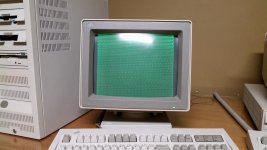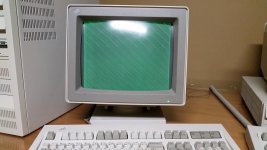404TimeNotFound
Experienced Member
So I've been attempting to get my SGI IrisVision and IBM caddy CD ROM drive to work in my PS/2 Model 95 under PC DOS 7 on and off for the past week or so now with little luck.
Starting with the CD drive, It's currently partially working, in that IBMCDROM.SYS loads and detects a CD drive and allows me to *access* it (switch to E: ) however ASPCDROM.SYS loads but does not detect a CD drive and I can't actually access the drive or any media in it, if that makes any sense. I've triple checked my autoexec.bat and config.sys files and can't seem to find anything wrong there. I know the page at ohlandl says to use ASPI.4B.SYS however I can't seem to download the file, it just opens in my browser as an audio file I can't play. Other than using that one driver though it seems I've done everything as I should, which makes me think I need to use said driver. Now onto the IrisVision...
I was actually really excited when I first got my hands on this, however that quickly wore off as I've done nothing but struggle in attempting to get it to work. I've since downloaded and installed what I thought was the proper software off of the ohlandl page for the IrisVision, but still have had little luck in getting it running. The ADF files are installed and the card itself is detected in the setup program, however it only lists the card under slot two, instead of two and three as it occupies both (I'm not sure if this is normal or not). As for when I'm in DOS whenever I try and run a demo or anything aside from the configuration program (which I have used to properly configure the settings for my display) it comes up with a message saying that "The 386 chip is currently executing in virtual 8086 mode under the control of another program" and that I have to close whatever program that is to use "386 DOS Extender", however before I started muddling around with my CD issues it would come up with GL_DREX (GLR_DEX?) or something similarly named had failed to load upon trying to run a demo, and the test program would work as well which I did run a few times (it only resulted in a green flash and then displayed scrolling diagonal green lines, though it claimed that it had passed).
Sorry for my (probably) rookie questions, I've never done much of anything with DOS until now aside from shoving it and a few programs onto computers. Any help with this would be appreciated, especially with the CD drive as I'm trying to install OS/2 Warp 4 Server onto my two disk RAID.
Starting with the CD drive, It's currently partially working, in that IBMCDROM.SYS loads and detects a CD drive and allows me to *access* it (switch to E: ) however ASPCDROM.SYS loads but does not detect a CD drive and I can't actually access the drive or any media in it, if that makes any sense. I've triple checked my autoexec.bat and config.sys files and can't seem to find anything wrong there. I know the page at ohlandl says to use ASPI.4B.SYS however I can't seem to download the file, it just opens in my browser as an audio file I can't play. Other than using that one driver though it seems I've done everything as I should, which makes me think I need to use said driver. Now onto the IrisVision...
I was actually really excited when I first got my hands on this, however that quickly wore off as I've done nothing but struggle in attempting to get it to work. I've since downloaded and installed what I thought was the proper software off of the ohlandl page for the IrisVision, but still have had little luck in getting it running. The ADF files are installed and the card itself is detected in the setup program, however it only lists the card under slot two, instead of two and three as it occupies both (I'm not sure if this is normal or not). As for when I'm in DOS whenever I try and run a demo or anything aside from the configuration program (which I have used to properly configure the settings for my display) it comes up with a message saying that "The 386 chip is currently executing in virtual 8086 mode under the control of another program" and that I have to close whatever program that is to use "386 DOS Extender", however before I started muddling around with my CD issues it would come up with GL_DREX (GLR_DEX?) or something similarly named had failed to load upon trying to run a demo, and the test program would work as well which I did run a few times (it only resulted in a green flash and then displayed scrolling diagonal green lines, though it claimed that it had passed).
Sorry for my (probably) rookie questions, I've never done much of anything with DOS until now aside from shoving it and a few programs onto computers. Any help with this would be appreciated, especially with the CD drive as I'm trying to install OS/2 Warp 4 Server onto my two disk RAID.
Last edited:



